All projects, or more generally, proposals for change, should be consistent with the business model. A project whose results are not consistent with the stated goals of the organization should not have a raison d'être. A proposal for an offering that does not enable the implementation of the company's strategy, or that does not meet the stated goals and needs of stakeholders, should not be implemented."[1]
Of course, this approach requires a certain organizational maturity - awareness of the importance and consequences of decisions, the existence of a certain structure of information, transparency - which is not always the case in an organization. Moreover, this approach requires an analysis of the current state, the environment and the resulting need for change, the establishment of a projected future state, goals, measures for meeting those goals, establishing accountability, developing plans... It requires - gosh darn it! - thinking! Thus, one looks in vain for such a model, or even for an awareness of causal analysis or business motivation in many companies desperately focused on their "here and now" or operating on a "everything yesterday" (and of course - cheap) basis. One looks in vain for such an approach in companies focused solely on quick profits.
However, since within the framework of this publication we are concerned with quality and the establishment of means to achieve quality, organizations of this nature will not be considered further. After all, it is difficult to look for the quality of an offer in organizations that do not provide this quality, cannot and does not want to provide it - because they have not developed an internal culture of quality, colloquially speaking: "does not feel" the subject.
But what to do in a situation where there is no need or opportunity to develop an entire BMM model? "Lighter" methods and solutions come to the rescue - among others, the proposal of the BABOK® Guide with its problem declaration model or the "agile" product vision, an excellent explanation of which can be found in the publications of Roman Pichler[2].
| Problem | Problem description | | | | | | | Stakeholders affected by the problem | Whose impact | What is the impact of the problem on each stakeholder | The effective solution will be... | List of key benefits of an effective solution to the problem | | | List of key benefits of an effective solution to the problem.
Source: compiled from BABOK® Guide 2.02[3].
We already know how to approach the problem of motivation analysis for an idea. Let's move on to the next element --- how to justify the value proposition of the offering (idea) to the business? Does it take more than demonstrating that an idea is consistent with the vision, goals and generally seems to support the organization's business?
We already have the vision, the goals, we know how to measure them. But how do we make sure - or more conservatively, verify - that the proposition of the offering actually has the potential to bring value to the organization, to the customer, or to stakeholders in general?
It is necessary to analyze this offer and, based on solid data (facts or reasonable estimates and projections), estimate the potential benefits of the idea, the total costs of realizing and implementing the offer, the risks - associated with both undertaking and not undertaking the venture. The collected information will be used to develop the so-called business case. A justification is, in the simplest terms, an argumentation aimed at demonstrating the added value of a project to the organization's business. A more formal definition can be found in the BABOK® Guide: "a business case is an explanation of a project proposal in terms of the value added to the organization and resulting from the implemented solution, compared to the cost of developing and operating the solution. The business case can include qualitative and quantitative benefits, cost and time estimates, expected returns and opportunities following the project (so-called follow up). The business case can present the expected consevences of activities in the context of financial flow and the methods used to express benefits and costs."
The business case can take a variety of forms - from a bound volume full of detailed information, statistics, forecasts, financial estimates, through a Power Point presentation, to a one-page document in the form of a mind map or a variant of a Canvas model.
Forma uzasadnienia ma drugorzędne znaczenie (co nie oznacza, że nie jest ważna - patrz [analiza interesariuszy]({{ "/o-interesariuszach-slow-kilka/" | prepend: site.baseurl }}) i wpływ ich wymagań oraz preferencji komunikacyjnych), w pierwszej kolejności należy zadać sobie pytanie o treść, a konkretnie o wymagania dotyczące informacji, które mają być zawarte w dokumencie. The basic components of a business case are presented in Figure 1 - so you can think of this mind map as a kind of checklist for building your own business case structure.

An example of an approach to developing a business case is a structured analysis of information that produces a specific result at each stage. Such analysis can be based on the following elements (Figure 2).
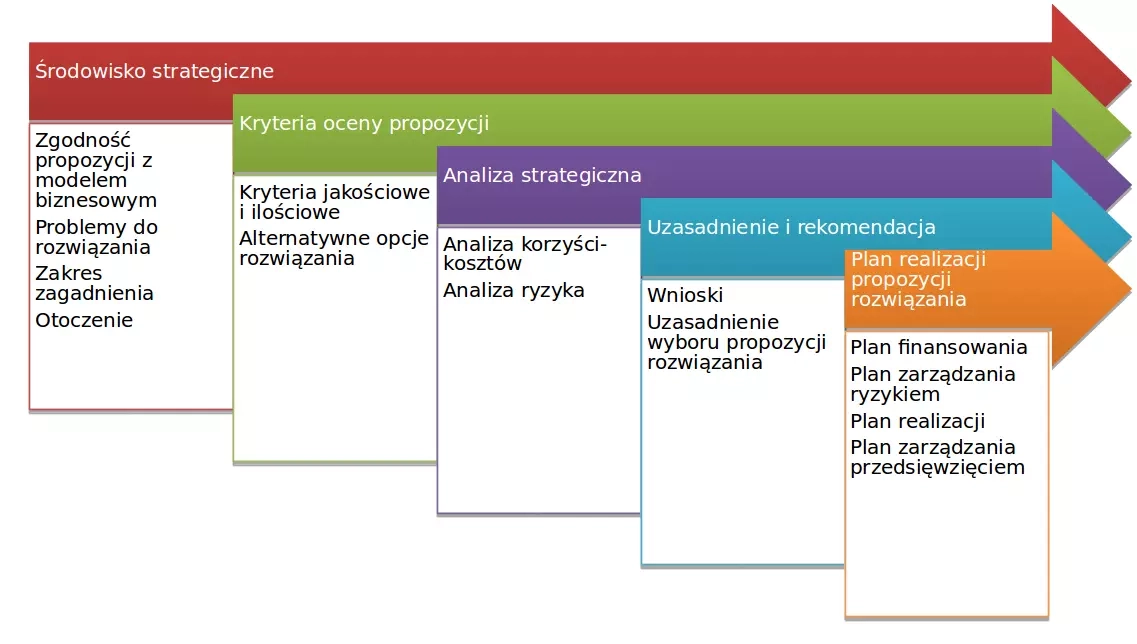
The results of the analysis can be presented in many ways - here are some of them.
Let's start with the "traditional" form of business case. Sources of patterns can be sought both in standards and good analytical practices (such as the BABOK® Guide) and, most importantly, in project management guidelines and methodologies[^4]. An example of a project management methodology that offers guidance for developing a business case is Prince2[^5]. According to Prince2, the business case should include the following elements[6]:
- Executive summary
- Reasons for undertaking the project (derived from the Project Preparation Order document)
- Possible business solutions
- It is worth mentioning here that the Prince2 methodology lists three options for responding to a proposal: do nothing, do the minimum, do as much as possible
- Expected benefits with a forecast of their achievement and a way to measure them
- Expected undesirable consequences
- Timelines
- Project implementation costs and the cost of maintaining the solution (e.g., an IT product)
- Evaluation of the investment, e.g. ROI/cost-benefit analysis
- Major risks (transferred from the Risk Register)
The requirements for the content of the business case can be implemented using various solutions. Figure 3 shows an example of a template document presenting the elements of the justification.
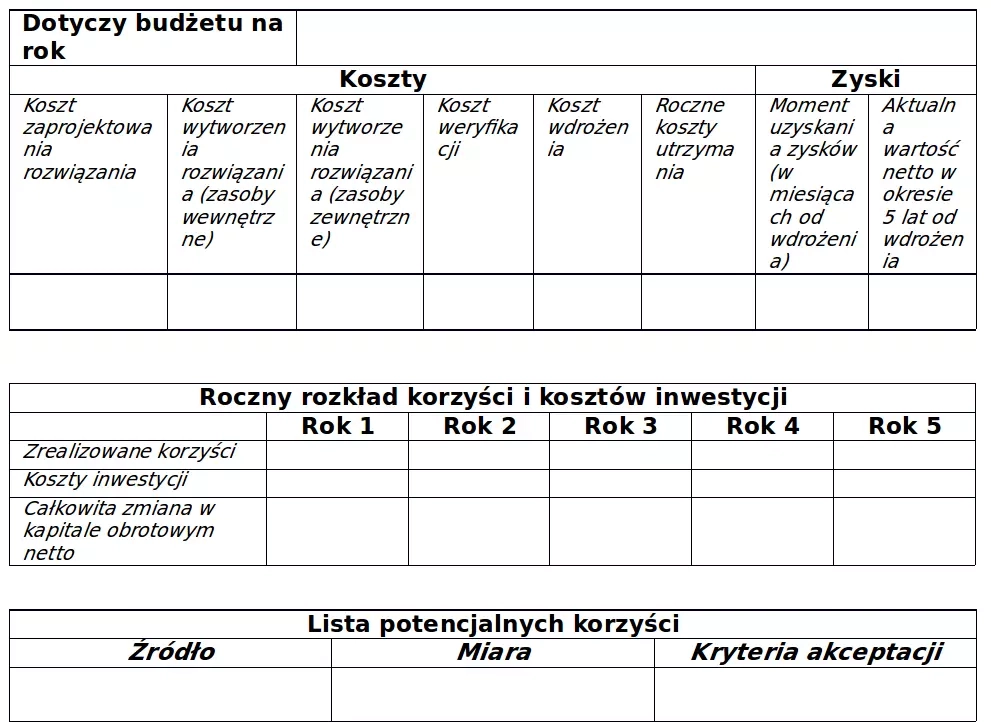
Source: compiled from: http://www.planninginnovations.com/single-post/2014/07/08/One-Page-Business-Case, accessed 07.05.2017.
The solution proposed by Prince2 may prove to be too formal in certain situations. Lovers of lightweight forms can look for inspiration in recently popular techniques and tools identified (often incorrectly, but that's a topic for another discussion) with the field of start-ups. One example is the Business Model Canvas (BCM) - an excellent "light" in form tool for developing an organization's business model, often used by product owners to design new solutions. BCM can be used as a form of business case for new business proposals - including services or products.
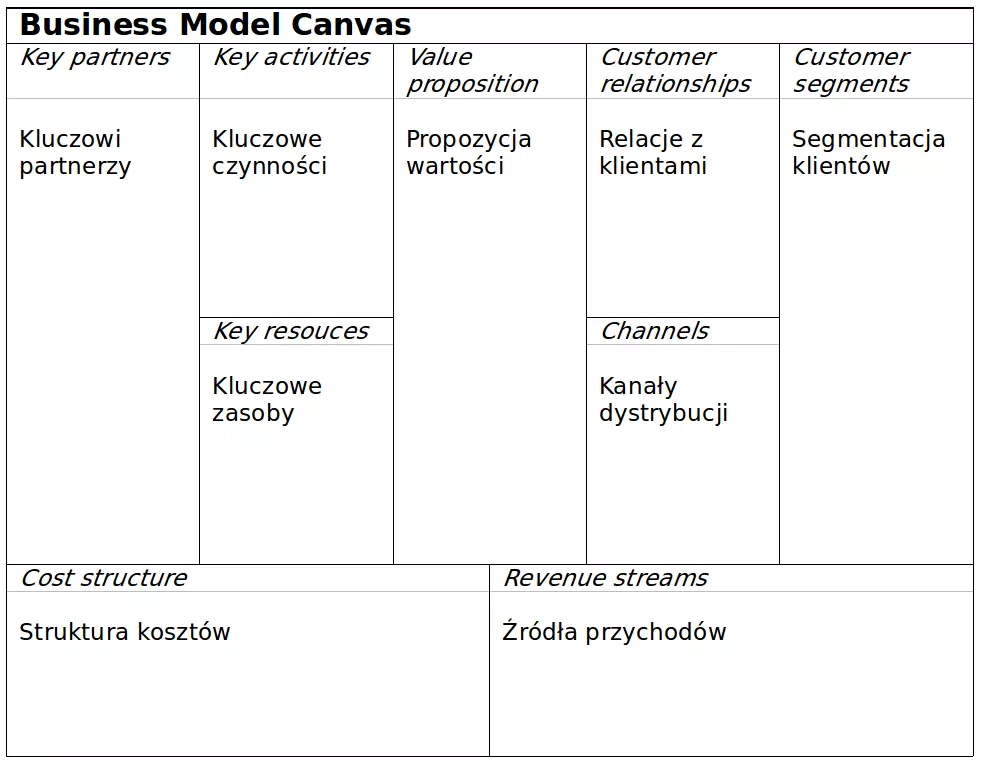
Source: compiled from Business Model Generation, A. Osterwalder, Y. Pigneur, A. Smith et al, own publication, 2010.
The Lean Canvas (developed by Asha Maurya[7] in the spirit of the Lean approach) operates on a similar basis, making minor modifications to the Business Model Canvas. In the Lean Can vas (LC), in place of key partners we insert a problem for which the solution is defined instead of key activities, instead of customer relations we analyze the advantage, and in place of key resources appear metrics[8].
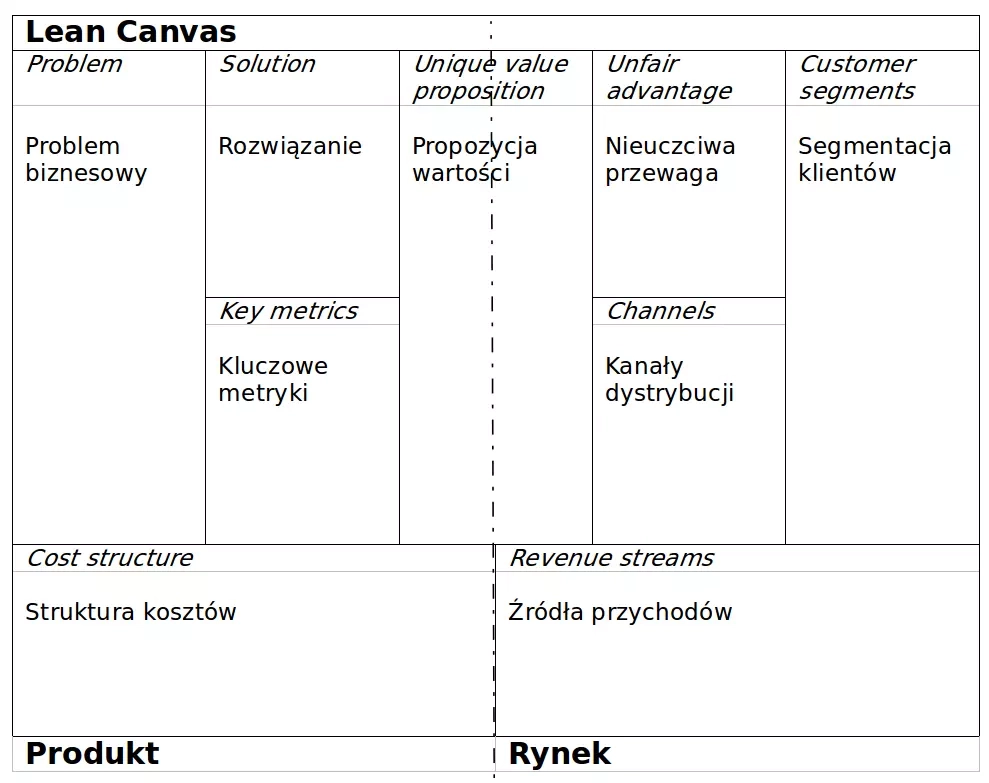
Source: compiled from materials by the author of Asha Maurya's method.
It is worth being aware of the fact that Canvas models perfectly and transparently show potential risks, both product and market risks. In addition, they also indicate the risks associated with potential customers (clients).
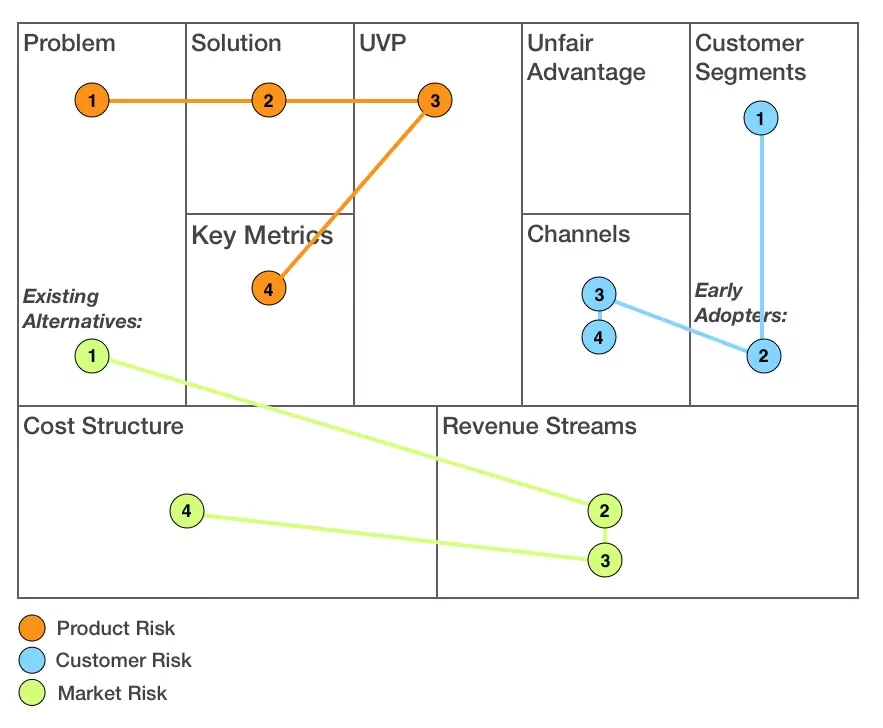
Source: http://productlabs.co/lean-canvas-model-biznesowy-na-kartce-a4/, accessed May 07, 2017 per Ash Maurya.
Examples of other solutions for preparing a business case are numerous - so there is no point in citing all the possibilities.
However, it is worth remembering one thing - when developing a business case for your own idea, I would recommend caution with hasty use of a random ready-made document template. This is because it may turn out that the available templates are too extensive for the basic information needs of our project - and we will end up with a grown-up document, with a lot of information and data acquired by the sweat of our brow, which no one will read in its entirety, because there will be no need to do so. There can also be the opposite situation. We will take advantage of the "light" template and prepare a document in the proverbial hour, after which it will be "crushed" by the recipients due to the lack of key content for the concept of design decisions (in which case there is a risk and for us as authors - the risk of loss of trust and an insult to the image of a professional). Therefore, I recommend a middle way - gaining knowledge about the sources of ready-made templates and guidelines, getting acquainted with the variants and possibilities, analyzing your own needs and information requirements of stakeholders and developing your own approach drawing from available sources. In doing so, it is important to keep in mind the primary purpose of a business case document: to justify the value of the project to the business. In this definition is largely hidden the answer to the question of the desirable information necessary in a given context to decide on the implementation of an idea.
Does it all have to be so complicated, the frustrated Reader will ask, compiling in his mind a slightly lengthy list of documentation required to start a project? No - it doesn't have to, because complicated it is not. It only requires awareness of the goals, means, opportunities, stakeholders, inputs, risks associated with our initiative. That is, knowledge of the context in which we plan to implement our idea. If this is missing, it will be difficult to carry out the project smoothly from the concept stage to the delivery of value - because we don't really know what we are doing, for whom, why, under what conditions and on what terms. If this is missing, it is difficult to talk about any quality management in the target project or organization - because this quality has never been recognized and defined. Quality was never there.
With this optimistic note, we conclude the third installment of the series. In the next installment, we will tackle the graceful topic of requirements.
All posts in this series:
- [In search of lost quality]({{ "/in-search-of-lost-quality/" | prepend: site.baseurl }})
- [About stakeholders a few words]({{ "/about-stakeholders-slow-something/" | prepend: site.baseurl }})
- [How to pave the way for business]({{ "/how-to-pave-the-way-for-business/" | prepend: site.baseurl }})
- [What is a business case]({{ "/what-is-a-business-justification/" | prepend: site.baseurl }})
The title of the series refers to Marcel Proust's series of publications "In Search of Lost Time", which is a record of the memories of the novel's protagonist. In the last volume of the series, the protagonist decides to write a novel describing his life which --- in his mind --- will enable him to regain lost time. In my series, I will use a similar procedure --- the series will begin with the earliest "stages of life", moving towards more and more advanced and mature themes, to reach a conclusion at the end....
Footnotes
[1]: It's worth noting that stakeholder goals don't necessarily have to be related to direct financial benefits or benefits at all --- an example is the need to implement a business change required by an external body (e.g., a change in legislation), while internal stakeholders only cause "extra work." [2]: http://www.romanpichler.com/tools/vision-board/, accessed May 07, 2017. [3]: A Guide to the Business Analysis Body of Knowledge® (BABOK® Guide) 2.0 [4]: First and foremost, because according to all best practices, as well as common sense, projects should be initiated based on decisions based on sound data and analysis that take into account, among other things, the profitability and risks of implementing the project. [5]: https://www.axelos.com/best-practice-solutions/prince2, accessed 07.05.2017. [6]: http://pl.prince2.wiki/Uzasadnienie_Biznesowe, accessed 07.05.2017 for Prince2. [7]: Method author's website: http://www.ashmaurya.com/2012/02/why-lean-canvas/, accessed 07.05.2017. [8]: The principle of filling in the fields in BMC and LC is clearly described, among others, at. http://www.biznesowerewolucje.com/model-biznesowy-business-model-canvas-lean-canvas/, accessed 07.05.2017.




